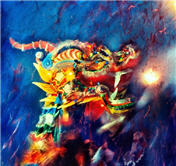Chinese New Year
Deborah Swallow | February 14th, 2010 in : days of significance, East Asia, General, social practices
Chinese New Year is rich in traditions, rituals and folklores. 
The celebrations take place over 15 days. It has been said that it is a combination of the US Thanksgiving, and Western Christmas and New Year. This is hardly an exaggeration! The origin of the Chinese New Year itself is centuries old – in fact, they say too old to actually be traced. All agree, however, that the word Nian, which in modern Chinese means “year”, was originally the name of a monster that preyed on people the night before the beginning of a new year. Previously, the Chinese lived in a totally agrarian society and only took a ‘holiday’ once a year after the harvest and before planting new crops. this coincided with the lunar New Year. The Chinese New Year is now popularly known as the Spring Festival because it starts from the Beginning of Spring.
In preparation, Chinese houses are cleaned from top to bottom, which is a ritual which is supposed to sweep away all traces of bad luck. Doors and windowpanes are often given a new coat of paint, usually red, then hung with paper decorated with themes such as happiness, wealth and longevity printed on them. New Year’s Eve is perhaps the most exciting part of the holiday festival – traditions and rituals are very carefully observed in everything from food to clothing. Dinner is usually a feast of seafood and dumplings, signifying different good wishes. Delicacies include prawns, for liveliness and happiness, dried oysters for all things good, fish dishes or Yau-Yu to bring good luck and prosperity, Fai-chai (Angel Hair – an edible hair-like seaweed) to bring prosperity, and dumplings boiled in water (Jiaozi) signifying a long-lasting good wish for a family. It is customary to wear something red as this colour is meant to ward off evil spirits. But black and white are frowned on this particular evening. After dinner, families sit up for the night playing cards, board games or watching television programmes dedicated to the occasion. At midnight, fireworks light up the sky.

Tags: Chinese New Year

 Hello, I'm Deborah Swallow and, for the last fifteen years, I've worked in over thirty countries addressing the complexities of people working internationally across multiple cultures, so individuals and organisations alike can gain an authentic competitive edge and win in international markets.
Hello, I'm Deborah Swallow and, for the last fifteen years, I've worked in over thirty countries addressing the complexities of people working internationally across multiple cultures, so individuals and organisations alike can gain an authentic competitive edge and win in international markets. 